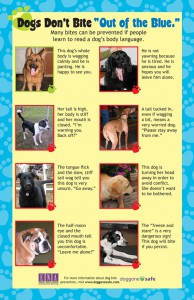Dogs do not speak a verbal language so the only way they can communicate with us is by using their body (and tones, which usually come after the body signals-see below). We need to know how to “listen” to our dogs by learning to read their body language in different situations. I can not tell you how many times I have heard from clients that a dog’s bite “came out of nowhere” when the dog was actually “telling” (probably screaming!) that he was uncomfortable in the situation, but no one was “listening” to him.
What exactly does your dog’s body look like when he is at home with you, on walks, with other dogs? What does he look like when he is relaxed and comfortable? Or uncomfortable? Did you know most dogs do not like hugs and kisses? Take a photo of your dog being hugged and see if you notice any of the stress signals below (tongue flicking, yawing, head turning and whale-eye are all commonly seen when a dog is hugged). If you are not sure if your dog wants your pets, go ahead and pet him for a few seconds and then stop. See what he does next – does he lean in for more (you are good – go for it!) or does he walk away (no thank you, he “says”).
Below are a few of the postures we see in dogs who are not comfortable. Take note of your own dog’s body language and see if he exhibits any of the ones listed below (or any others).
Freezing
Your dog freezes and stands completely still.
Hackles up
The fur on the dog’s back (from his neck to the base of his tail) rises. This can be a normal response when a dog encounters new dogs. It is his natural way of saying “look how big I am.” His hackles should go down once he has greeted a dog properly. It’s good practice to remove a dog from play (at least momentarily) if his hackles are up continuously since it tells us his arousal level is raised.
Staring
There is a difference between a “soft eye” – the loving look your dog gives you while you pet him on the couch, and a “hard eye.” Get to know the difference. Your dog should not be allowed to “hard stare” another dog. You may also see your dog with a “hard face” as opposed to his normal, relaxed “soft face”. Staring of this sort needs to be redirected immediately.
Tail
A high, wagging tail is not always a sign of “happiness” instead, it is often a sign of a dog in an aroused state. A low, slowly wagging tail or a full hind-end wag (usually horizontal to the floor) is ideal. A tail tucked between his legs is a sign of fear, insecurity or submission.
Ears
Which way are your dog’s ears going? Are they flat against his head, forward, erect? Can you see one ear going towards a sound or another dog even when your dog is not looking at him? Dogs with erect ears are particularly easy to read.
Raised Paw
Raising one paw off of the ground is often a sign of uncertainty “what am I supposed to be doing here” or insecurity.
Body posturing
“Big dog” posturing, slow movements or freezing, hackles up. Maybe putting his head over the other dog’s shoulders.
Stalking
Often seen with posturing. Following another dog around, tailing him.
Check out our Pinterest Board on Body Language for many more examples!
Learn more about body language at our Understanding Canine Body Language Webinar. If you would like to purchase a previously recorded webinar ($25) email Danette@dogsdayoutseattle.com
SIGNS OF STRESS
While taking note of your dog’s body language in different circumstances it is also important to observe your dog for common signs of stress. Some common signs of stress are listed below. If your dog is exhibiting any of these it is important to try to deal with whatever is stressing him. Always make sure to take these signs in context too – your dog may just be yawning because he is tired or lip licking because he just had some peanut butter 🙂
- Whining
- Yawning
- Lip Licking/Tongue Flicking
- “Whale eye” or “half moon eye” – a sideways glance showing the whites of the eye
- “Hard eye” or stare with intention
- Avoiding eye contact
- One front paw raised
- Closed, tight mouth
- Grinning
- Lip curling
- Furrowed brow
- Clinging to owner/trying to “climb” owner
- Mounting
- Shaking
- Barking
- Lip curling
- Snapping/biting
- Dilated pupils
- Piloerection (hackles up) – hair on back standing up
- Tense Ears or ears pinned back
- Panting
- Tongue way out or spatulate tongue
- Excess shedding
- Diarrhea/vomiting
- Urination/Defecation
- Restlessness
- Running/Attempt to flee
- Tail down
- Rigid, forward stance
- Freezing
- Shaking off (as when wet)
- Shutting down – not able to do cues he “knows”
- Acting silly
- Approach and withdraw
- Turning head
- Turning body away (C shape)
- Not taking treats
- Taking treats harder than usual
- Growling – (this one is obviously auditory but often comes as the 4th signal after orienting to the subject, freezing and staring).



